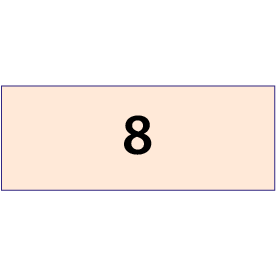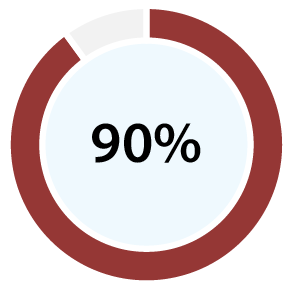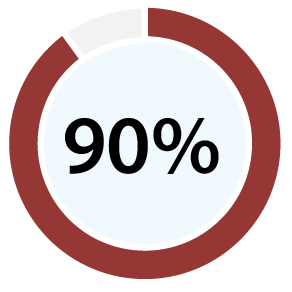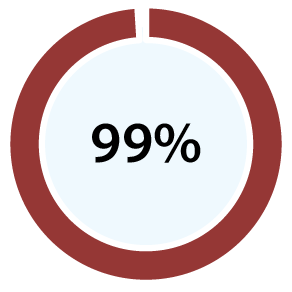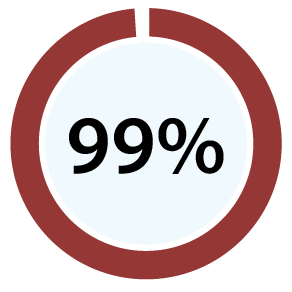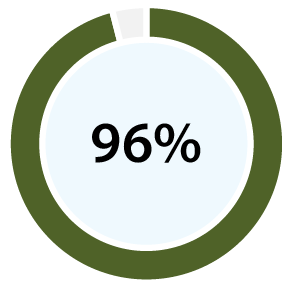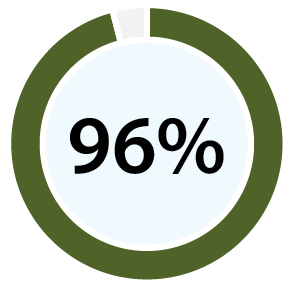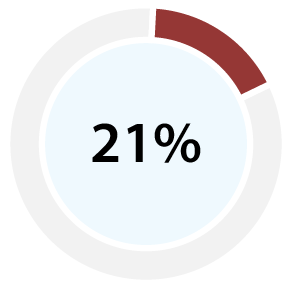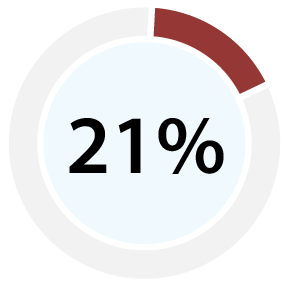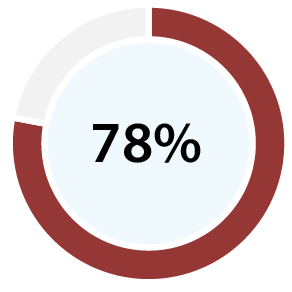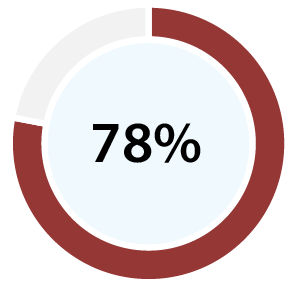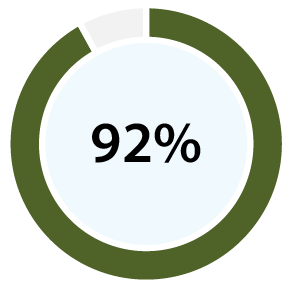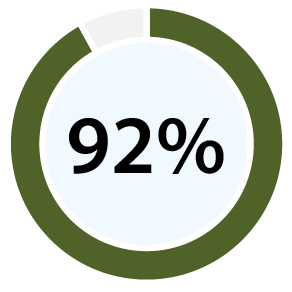Why choose OvuSense?
OvuSense is different from anything else you may have heard of, or used previously to monitor your fertility. That's because it is a family of clinically proven products designed to meet your needs at every step of your fertility journey.
What do I need to know when trying to conceive?
We're taught in school that it's easy to get pregnant: all that needs to happen is sperm and egg meet, and because you ovulate in the middle of the month if you have a 28 cycle you just need to try around day 14.... Right?
Wrong: in fact, clinical studies show that 70% of women don’t ovulate in the middle of their cycle, and you can ovulate at a different time from cycle to cycle, even if your cycles are always the same length [1]
You need two key pieces of information when you start out trying to conceive:
Question 1) When did I ovulate last cycle?
To know whether you are ovulating or not, and to help understand when to try in the next cycle if you are relatively regular. You can use our OvuFirst skin-worn sensor when starting out trying to conceive, or if you want the ultimate in accuracy you can use our OvuCore vaginal sensor.
Question 2) When am I going to ovulate this cycle?
OvuFirst and OvuCore will use your ovulation data to provide a full 8-day fertile window showing when best to try to conceive in the current cycle. If you have irregular cycles, or the timing of your ovulation is different then OvuCore has the added benefit that it can tell you when you're going to ovulate using the current cycle data - using our unique realtime prediction algorithm.
What our users say
find OvuSense much easier to use than other fertility tests or monitors*
of users would recommend OvuSense to a friend*
of users say they feel less stressed and more in control of their fertility*
* ongoing user study
How does it compare to fertility tracker apps?
How do they work?
Fertility Tracker Apps (FTAs) use the calendar based method of tracking. You input the dates of your period and the app will calculate your ovulation based on the assumption that you have 'middle of the month' ovulation. Some have more sophisticated algorithms which accept manually entered oral temperatures, or Ovulation Predictor Kit (Luteinizing Hormone) test results.
How close will the results be compared to OvuSense?
Even though Fertility Tracker Apps (FTAs) sometimes allow you to enter information other than just your period dates, they are not able to pinpoint the date of ovulation with useful accuracy because they are based on the assumption that all women have very regular cycles with ovulation that occurs in the 'middle of the month' Of all the methods for looking at your ovulation you need to know that FTAs are the least reliable, and you should really ignore the results they produce if you're struggling to conceive.
What are the benefits?
Fertility apps are convenient and a handy way of tracking the basic information in your cycle. They help you stay organised and often feature useful extra information to help with conception and pregnancy.
What are the drawbacks?
Clinical studies show that 70% of women don’t ovulate in the middle of their cycle, and you can ovulate at a different time from cycle to cycle, even if your cycles are always the same length [1]. A recent study into several fertility apps concluded 'as a result of the physiological variations of the menstrual cycle length and ovulation day, the fertile window cannot be predicted easily, and it has to be determined during the ongoing cycle. Therefore, to help couples wishing to conceive, apps based on data from previous cycles alone are not suitable to indicate the most fertile days' [2]. Another recent study concluded 'accuracy of ovulation prediction [using previous cycle data] was no better than 21%' [3]. Other studies have drawn similar conclusions [4].
[1] Baird D, McConnaughey D (1995); Lenton EA, Landgren BM (1984a); Lenton EA, Landgren BM (1984b)
[2] Freis A, Freundl-Schütt T (2018)
[3] Johnson S, Marriott L (2018)
[4] Freundl G, Godehardt E (2003); Moglia ML, Nguyen HV (2016); Wise LA, Hatch EE (2015)
How does it compare to basal body temperature tracking?
How does it work?
Long established in the clinical literature [1], the BBT method aims to help detect the date of ovulation in a cycle by taking the basal (lowest) temperature first thing on waking with an oral thermometer, and then charting the change in this daily temperature throughout the month to determine the date of ovulation. It can also be used if you have regular ovulation for predicting the fertile window in the next cycle. Because a rise in temperature is associated with the release of progesterone which occurs during ovulation, a predictable pattern emerges for most women which can help confirm ovulation took place over a number of cycles.
How close will the results be compared to OvuSense?
Even though the Basal Body Temperature (BBT) method uses temperature as a basis for confirming if ovulation took place, it relies on very different measuring technology from the patented protected system used by OvuSense. Oral thermometers only have an accuracy of around 0.1 degrees Celsius [a] so are not easily able to detect the 0.3 degree rise associated with ovulation with accuracy. Even if you type the values you get with your thermometer into a Fertility Tracker App they are likely to give a different ovulation result from OvuSense. You should also be aware that a vaginal temperature measured using the OvuCore Sensor is generally up to two degrees Celsius higher than temperature readings taken in the mouth, and higher still than external temperature readings such as those taken under the armpit or on the wrist. Lastly, OvuSense uses proprietary algorithms to detect ovulation, so it can produce very different results even with similar looking temperature curves.
What are the benefits?
BBT is a relatively cheap and easy way to track your temperatures and a number of apps are now available which combine the idea of a single oral temperature with automatic charting. It is more effective if combined with cervical mucus tracking.
What are the drawbacks?
Clinical studies show that 70% of women don’t ovulate in the middle of their cycle, and you can ovulate at a different time from cycle to cycle, even if your cycles are always the same length [2]. As a result because BBT relies on predicting the fertile window based on past cycle data, it's of little practical use if you don't ovulate at the same time each month. With or without an app to help, BBT is unable to help predict ovulation using the current cycle data. Again, even with an app, some users find the charting cumbersome and have difficulty taking a valid measurement each day. Studies assess accuracy for confirmation that ovulation took place at around 69%-78%[3].
[1] Barrett JC Marshall J (1969); McCarthy and Rockette (1983) [2] Baird D, McConnaughey D (1995) Lenton EA, Landgren BM (1984a); Lenton EA, Landgren BM (1984b) [3] Freundl G, Godehardt E (2003); Barron M L Fehring R (2005); Bauman JE (1981)
How does it compare to skin worn devices?
How do they work?
A more modern application of the BBT method is to take several consecutive temperature measurements from the skin - either under the armpit, under the bra strap or on your wrist - at various intervals overnight, and then download and interpret these measurements on an app. Some of these devices record additional secondary parameters.
How close will the results be compared to OvuSense?
Even though Skin Worn/ Fertility Bracelet Devices (SW/ FB) use skin temperature as a basis for confirming if ovulation took place, they rely on very different measuring technology from the patented protected system used by OvuSense. They also use different algorithm methods, and you therefore shouldn't expect them to give you the same temperature or ovulation results. You should also be aware that a vaginal temperature measured using the OvuCore Sensor is generally up to two degrees Celsius higher than temperature readings taken in the mouth, and higher still than external temperature readings such as those taken under the armpit or on the wrist.
What are the benefits?
As with the BBT method, a skin worn device is a relatively easy way to track your temperatures and it's often more convenient. The devices help establish the pattern of temperature over time, and because of the volume of measurements, they are possibly a little more consistent in detecting ovulation than BBT with an oral thermometer.
What are the drawbacks?
Measuring temperature at the skin also has some negative aspects for devices that have not been optimised through side by side clinical testing with 'gold standard' methods. Firstly, the skin temperature tends to vary in opposition to core temperature changes associated with the release of progesterone, and secondly there is a high chance of 'dropouts' in the temperature signal because it's difficult to maintain contact between the skin and sensor consistently. Just as with BBT, these devices rely on predicting the fertile window based on past cycle data, so they are more suited to women with regular cycles.[2] They are unable to predict ovulation using current cycle data. There are no current papers assessing accuracy of the ability to confirm the date of ovulation, but published data for a wrist worn device shows a sensitivity of 81% (missing around 19% of ovulations) and an ability to confirm that ovulation took place within a fertile window (though not on which day) with a 'F score' of 0.78 which indicates 78% accuracy [3].
[1] Barrett JC Marshall J (1969); McCarthey and Rockette (1983)
[2] Baird D, McConnaughey D (1995); Lenton EA, Landgren BM (1984a); Lenton EA, Landgren BM (1984b)
[3] Goodale BM, Shilaih M (2019)
How does it compare to urine tests/ ovulation predictor kits?
How do they work?
Ovulation Predictor Kits (OPKs) provide a positive test for Luteinizing Hormone (LH) using a urine test strip. Ovulation Prediction Monitors (OPMs) usually allow multiple ovulation predictor urine strip results to be combined to provide a monitoring picture of Luteinizing Hormone (LH) over a cycle. Some monitors use a urine strip that combines LH with E3G - a metabolite that allows assessment of the estradiol level.
How close will the results be compared to OvuSense?
Firstly, OPKs and OPMs are only able to provide a prediction of when ovulation may occur during the current cycle. They are not able to confirm you have ovulated, and because of the lack of confirmation they cannot be used to reliably predict your fertile window for the next cycle. When you're using the OvuCore Sensor your OvuSense App will also provide you with a prediction of when you are about to ovulate using the current cycle data. As this is based on the temperature pattern caused by the release of progesterone associated with ovulation, rather than luteizing hormone, it may well provide you with a different prediction. This is particularly true if you have an ovulatory issue such as PCOS which is known to interfere with OPK and OPM results. However, if your OvuSense App and an OPK or OPM predict the same day for ovulation then this can be very useful in confirming your hormone behaviour throughout the cycle.
What are the benefits?
LH peaks up to a day in advance of ovulation so OPKs and OPMs are helpful in providing a short term indication of when you should try and conceive based on your current cycle data. They work well at predicting ovulation for most women that have regular 'middle of the month' ovulation. The addition of E3G with OPMs helps provide a fertile window prediction and storing multiple results in the monitor helps with the convenience and monitoring over time compared with OPKs.
What are the drawbacks?
OPKs are known to give false positive results for women with PCOS and other ovulatory issues [1]. They sometimes also give false negative results, which can be based on the cutoff point of the test, or simply that the test is not optimised for the natural level of LH for the particular user. OPKs can only provide a snapshot at one point in time in your cycle, meaning you have to use a minimum of two tests a day over a 10-20 range in each cycle to monitor where you are in your cycle. The manufacturers make valid claims for 99% accuracy in detecting LH, but the accuracy estimates for correct advance prediction of ovulation are 70%-84% depending on the publication [2]. OPKs and OPMs are unable to confirm the date of ovulation or if you haven't ovulated. They are sometimes thought to be messy, impractical and the cost quickly adds up. Lastly, they cannot be used for clinical monitoring as they only provide a picture up to the point of ovulation and no understanding of what happens during ovulation itself, and the luteal phase.
[1] McGovern PG, Myers ER (2004)
[2] Irons DW, Singh M (1994); Lloyd R, Coulman CB (1989);
Endorsed by doctors and fertility specialists, and able to work whatever is happening in your cycle, why use anything else? OvuSense is helping women all over the world just like you to take control of their fertility.
Which fertility monitor is right for me?
Compare OvuSense with other methods for monitoring your ovulation and reproductive cycle.
As you consider which fertility monitor fits you best some typical things to consider are:
- How large a fertile window will it detect so you can maximize the time when you're trying to conceive
- How accurate is it at confirming ovulation - the less accurate the less chance of it helping you in your next cycle
- Can it predict ovulation using the current cycle data - something we like to call realtime prediction
- Does the system work for PCOS and irregular cycles
- Can it help your doctor screen for fertility issues
- Can it help you and your doctor monitor your medication or treatment
Each of the statistics quoted below are derived from clinical evidence available on fertility monitoring methods and products. Pro refers to the OvuSense Pro clinician portal. Click on the 'i' icon next to each method in the table, or directly on the method in the table on mobile devices to find out more about the clinical evidence.
OvuFirst (OF)
OvuSense (OS)
Fertility Tracker Apps (FTA)
Basal Body Temperature (BBT)
Skin Worn/ Fertility Bracelet Devices (SW/ FB)
Ovulation Predictor Kits and Monitors (OPK/ OPM)
Serum Progesterone (SP)
Ultrasound (US)
Fertility Testing Methods Key
- OF OvuFirst (Skin Temperature)
- OS Core OvuSense OvuCore (Core Body Temperature)
- BBT Basal Body Temperature
- FTA Fertility Tracker Apps
- SWD Skin Worn Devices
- FBD Fertility Bracelet Devices
- OPK Ovulation Predictor Kits (urine strips)
- OPM Ovulation Prediction Monitors (urine strips)
- SP Serum Progesterone
- US Ultrasound


